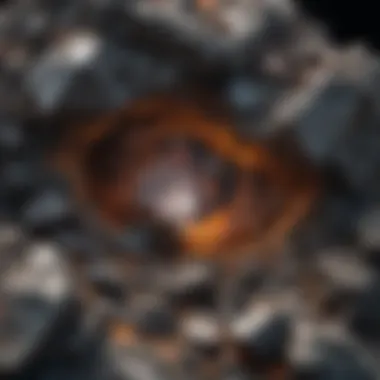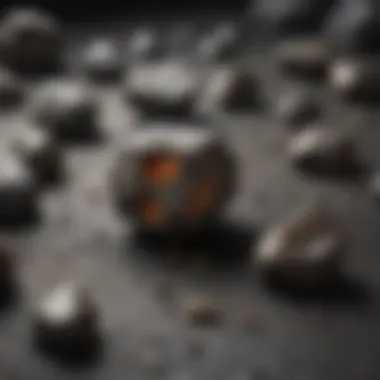Unveiling the Crucial Role of Meteorite Testing in Geological Research


Rock Identification and Significance
In the realm of geological research, understanding the significance of meteorite testing is paramount. Meteorites provide invaluable insights into celestial origins and the geological evolution of our planet. When it comes to rock identification, various types of meteorites exist, each with unique characteristics that offer clues about the universe's formation and Earth's development. Geologists scrutinize these rocks for signs of extraterrestrial origins and rare minerals that can shed light on the early history of our solar system. Utilizing specialized tools such as microscopes and spectrometers, researchers are able to analyze the composition and structure of meteorites in meticulous detail.
Types and Characteristics
Meteorites come in different classes, including stony, iron, and stony-iron meteorites. Stony meteorites are primarily composed of silicate minerals, offering insights into the formation of planetary bodies. Iron meteorites consist predominantly of iron and nickel alloys, providing clues about the core of asteroids. Stony-iron meteorites, which contain both rocky and metallic components, are rare and highly prized for their scientific significance. Characteristics such as fusion crust, regmaglypts, and chondrules play crucial roles in determining the origin and history of meteorites.
Tools for Identification
Identifying meteorites requires a keen eye and specialized equipment. Hand lenses, magnets, streak plates, and ultraviolet lights are commonly used tools for preliminary assessments. More advanced techniques like thin section analysis, X-ray diffraction, and electron microprobe analysis provide detailed information about the mineral composition, texture, and structure of meteorites. By combining visual examination with sophisticated analytical instruments, scientists can unravel the complex mysteries hidden within these extraterrestrial rocks.
Introduction to Meteorite Testing
Understanding Meteorites
Types of Meteorites
Types of meteorites represent a crucial aspect of meteorite testing due to the diverse insights they provide into celestial phenomena. Each type, whether stony, iron, or stony-iron, offers unique chemical compositions and physical characteristics that aid researchers in pinpointing their origins. Understanding the types of meteorites is essential for narrowing down their source regions in space and comprehending their journey to Earth, thereby enriching the geological research landscape.


Composition of Meteorites
The composition of meteorites serves as a critical element in meteorite testing, shedding light on their internal structure and elemental makeup. By analyzing the minerals and compounds present in meteorites, scientists can gain valuable information about the processes that shaped these celestial bodies. This detailed analysis fuels geological inquiries and contributes significantly to our knowledge of planetary materials.
Origins of Meteorites
Exploring the origins of meteorites is instrumental in understanding their place in the solar system and beyond. By unraveling the complex history of meteorite formation and ejection from parent bodies, researchers can draw connections between different meteorite groups and their respective origins. This knowledge enhances our grasp of planetary dynamics and the mechanisms that govern celestial phenomena.
Methods of Meteorite Testing
In the realm of geological research, the methods of meteorite testing stand as a cornerstone in unraveling the complex mysteries of celestial origins and the evolution of our planet. These methods play a crucial role in providing invaluable insights into the composition, structure, and history of meteorites. By employing sophisticated analytical techniques and advanced laboratory procedures, scientists can decipher the secrets held within these extraterrestrial objects.
The significance of methods of meteorite testing in this article lies in their ability to facilitate a deeper understanding of the geological processes that have shaped our universe. From spectroscopy to isotopic analysis to microscopic examination, each method offers a unique perspective on the characteristics of meteorites, shedding light on their origins and their potential impact on Earth.
- Analytical Techniques
Spectroscopy
Spectroscopy, a key analytical technique in meteorite testing, plays a pivotal role in identifying the elemental composition of meteorites. By analyzing the light emitted or absorbed by these extraterrestrial rocks, spectroscopy allows scientists to determine the presence of specific elements and isotopes. This method is particularly beneficial in this article as it enables researchers to link meteorites to their celestial sources and understand the processes that have shaped them. However, the limitation of spectroscopy lies in its inability to provide detailed structural information about meteorites.


Isotopic Analysis
Isotopic analysis is another vital component of meteorite testing, offering insights into the age and formation history of these cosmic rocks. By studying the ratios of stable and radioactive isotopes within meteorites, scientists can infer details about the conditions prevailing in the early solar system. This method proves advantageous for this article as it aids in dating meteorites and unraveling the events that have influenced their evolution. Nonetheless, isotopic analysis requires sophisticated equipment and may be limited by the availability of suitable samples.
Microscopic Examination
Microscopic examination serves as a crucial tool in investigating the textures and mineralogical features of meteorites at a microscale level. By scrutinizing thin sections of meteorite samples under powerful microscopes, researchers can identify minerals, textures, and structural relationships within these extraterrestrial rocks. This method is valuable in this article as it allows for detailed petrographic analysis and the characterization of meteorite components. Yet, the drawback of microscopic examination lies in its dependence on sample quality and preparation techniques.
Laboratory Procedures
Within the realm of meteorite testing, laboratory procedures play a fundamental role in ensuring the accuracy and reliability of analytical results. These procedures encompass sample preparation, chemical analysis, and mineralogical studies, all of which contribute to the comprehensive evaluation of meteoritic material. By adhering to strict protocols and employing state-of-the-art equipment, scientists can unravel the secrets hidden within meteorites.
The importance of laboratory procedures in this article lies in their role in facilitating a detailed examination of meteorite specimens, allowing researchers to deduce crucial information about their origins and histories. Through meticulous sample preparation, precise chemical analysis, and comprehensive mineralogical studies, scientists can obtain a holistic view of meteorites and their significance in geological research.
- Advanced Testing Methods
Radiometric Dating
Radiometric dating stands as a powerful technique in determining the age of meteorites based on the decay of radioactive isotopes. By measuring the ratios of parent and daughter isotopes within meteoritic samples, scientists can calculate their absolute ages, providing essential chronological information for understanding planetary evolution. This method proves invaluable for this article as it offers a precise means of dating meteorites and deciphering the timelines of celestial events. However, radiometric dating may be influenced by external factors that could affect the accuracy of age determinations.


X-ray Diffraction
X-ray diffraction plays a vital role in investigating the crystalline structures and mineral phases present in meteorites. By analyzing the diffraction patterns generated when X-rays interact with a sample, scientists can identify the mineralogical composition of meteoritic material. This method is significant in this article as it allows for the detailed characterization of meteorite minerals and their crystallographic properties. Nevertheless, X-ray diffraction may pose challenges in distinguishing between closely related mineral phases within meteorites.
Mass Spectrometry
Mass spectrometry serves as a sophisticated technique for measuring the masses of ions generated from meteoritic samples, enabling the identification of isotopic compositions and elemental abundances. By employing mass spectrometry, researchers can unravel the isotopic signatures of meteorites and gain insights into their formation processes. This method is essential in this article as it offers a high level of precision in analyzing meteorite components. However, mass spectrometry requires careful calibration and maintenance to ensure accurate results.
Applications of Meteorite Testing
In the realm of geological research, meteorite testing plays a crucial role in unraveling the mysteries of celestial origins and geological evolution. It serves as a key tool for scientists to delve into various aspects related to meteorites and their significance. By exploring the applications of meteorite testing, researchers can gain valuable insights into the composition, origins, and evolution of these extraterrestrial objects. The analytical techniques and laboratory procedures involved in meteorite testing offer a window into the history of our planet and the universe at large.
Earth's Geological Evolution
Impact Events and Crater Studies
Impact events and crater studies are pivotal components of meteorite testing, shedding light on the history and geological evolution of Earth. By examining impact craters and the debris left behind by meteorite impacts, scientists can piece together the timeline of significant events that have shaped our planet. The analysis of impact sites provides valuable data on the nature of celestial bodies that have interacted with Earth, offering insights into the dynamics of our solar system.
Subsurface Composition Analysis
Subsurface composition analysis delves into the depths of geological formations, uncovering hidden clues about Earth's past and present. By studying the composition of subsurface materials affected by meteorite impacts, researchers can gauge the impact's intensity and implications for planetary evolution. This aspect of meteorite testing enhances our understanding of geological processes and the interplay between external forces and Earth's structure.
Geochronology and Stratigraphy
Geochronology and stratigraphy form the backbone of geological research, providing a timeline of Earth's evolution through the ages. By dating meteorite impact events and correlating them with stratigraphic records, scientists can construct a comprehensive chronology of geological events. This deep dive into Earth's history unveils the interconnectedness of celestial phenomena and terrestrial developments, offering a holistic view of our planet's evolutionary journey.







